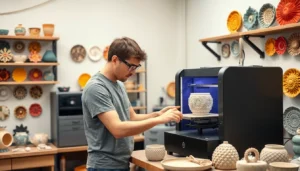Table of Contents
ToggleImagine a world where building a house is as easy as hitting “print” on your 3D printer. Welcome to the future of construction, where 3D printing is revolutionizing how we create everything from cozy homes to towering skyscrapers. This tech marvel isn’t just about fancy gadgets—it’s about efficiency, sustainability, and a sprinkle of creativity that traditional methods can’t match.
Overview of 3D Printing in Construction
3D printing in construction leverages additive manufacturing technology to create buildings layer by layer. This method significantly reduces material waste and construction time. Using robotic systems, construction firms can produce intricate designs that traditional techniques often struggle to achieve.
Structural components manufactured through 3D printing include walls, foundations, and even roofing systems. Studies show that these elements can be produced in a fraction of the time compared to conventional methods, with some structures completed in days rather than months. Materials commonly used include concrete, polymers, and composites that enhance durability and sustainability.
Incorporating 3D printing can also lower labor costs, as fewer workers are required on-site. Automation drives efficiency, allowing teams to focus on oversight rather than manual construction tasks. Additionally, the reduction in manual labor contributes to improved safety conditions, minimizing the risk of workplace injuries.
Sustainability plays a crucial role in the adoption of 3D printing. By utilizing recycled materials and reducing waste, this technology aligns with global efforts to promote eco-friendly practices in the industry. Cities around the world are beginning to embrace 3D printing for affordable housing solutions, enabling quicker responses to population growth.
Overall, 3D printing presents a revolutionary approach in construction, demonstrating its influence on future architectural practices and urban development. As innovation continues, the full potential of this technology in reshaping the building landscape becomes increasingly apparent.
Benefits of 3D Printing in Construction
3D printing in construction offers significant advantages that reshape how buildings are designed and constructed. Key benefits include cost efficiency and speed of construction.
Cost Efficiency
Reduced expenses characterize 3D printing. Traditional construction methods involve high labor costs and material waste, whereas 3D printing minimizes these factors. Projects utilizing this technology cut costs by as much as 30 percent, making them economically appealing.
Fewer workers on-site also contribute to lower labor expenses, which streamlines project budgets. Various materials can be recycled, further driving down costs. The ability to print intricate structures without additional materials reduces waste and enhances resource utilization.
Speed of Construction
Rapid project completion defines 3D printing in construction. Projects that typically take months can be reduced to weeks, expediting the building process significantly. This technology allows for continuous operation, producing substantial structural elements quickly.
Complex designs can be executed in shorter time frames, addressing urgent housing needs effectively. Additionally, faster construction helps relieve housing shortages, especially in rapidly growing urban areas. Overall, swift project execution reinforces 3D printing’s appeal as a transformative technology for the construction industry.
Technologies Used in 3D Printing
Various technologies drive the advancements in 3D printing within construction. Key methods include material extrusion and powder bed fusion.
Material Extrusion
Material extrusion represents one of the most common 3D printing techniques in construction. This method involves a nozzle that extrudes material, typically thermoplastics or concrete, to form layers. As each layer builds upon the previous one, structures emerge efficiently. Significant advantages include reduced labor costs and minimized material waste. Ongoing innovations in filament formulations enhance strength and durability, making constructions more robust. Many companies utilize this technique to create walls and other components rapidly, ensuring that projects meet tight deadlines while maintaining quality standards.
Powder Bed Fusion
Powder bed fusion offers a different approach to 3D printing in construction. This technology uses a laser or electron beam to fuse particles from a powdered material, such as metal or plastic, layer by layer. High precision and detailed designs define this method, allowing intricate architectural elements to materialize seamlessly. Construction projects benefit from its ability to create complex shapes that traditional methods struggle to achieve. Furthermore, the potential for using recycled powders supports sustainability efforts in the construction industry. Increased efficiency in material utilization helps deliver exceptional results for futuristic designs.
Current Applications in Construction
3D printing technology finds numerous applications in construction, enhancing efficiency and sustainability across various sectors.
Residential Buildings
3D printing revolutionizes the construction of residential buildings. By utilizing additive manufacturing, companies create entire homes in a matter of days. This method allows for lower material waste, frequently up to 90 percent less compared to traditional construction. Cities worldwide are adopting this technology to address housing shortages rapidly. Recent projects in locations like Mexico and the U.S. demonstrate how 3D-printed homes can be produced at a fraction of the cost, with some estimates showing savings of 20 to 30 percent on overall expenses. Innovative materials, often including recycled content, contribute to eco-friendly construction practices.
Commercial Structures
Commercial structures increasingly benefit from 3D printing as well. This approach allows architects and builders to construct office buildings and retail spaces more quickly and affordably. For instance, projects in Europe have showcased 3D-printed elements, reducing build times from months to weeks. Customization becomes simple, with intricate designs achieved easily without significant labor costs. Companies report that using 3D printing can lead to a 30 percent reduction in expenses associated with building materials and labor. Enhanced design capabilities enable collaborative efforts between architects and engineers, resulting in unique, functional spaces that meet corporate needs efficiently.
Challenges and Limitations
3D printing in construction faces several challenges that can impact its widespread adoption. Addressing these issues is crucial for realizing its full potential.
Regulatory Hurdles
Regulatory frameworks lag behind the advances in 3D printing technology. Building codes often lack guidelines specific to additive manufacturing. Local governments may struggle to approve 3D-printed structures due to unfamiliarity with the technology. Compliance with safety standards also presents challenges, as existing regulations typically focus on traditional construction methods. Companies often find themselves navigating a complex web of permits and inspections, which can slow project timelines. Collaboration between industry stakeholders and regulators is essential to streamline policies that govern 3D-printed buildings.
Material Limitations
3D printing relies heavily on specific materials, which currently include concrete and certain polymers. The selection of materials can limit design flexibility and structural performance. Not all materials used in conventional construction are viable for 3D printing, particularly those requiring specific properties, such as durability and load-bearing capacity. Additionally, the availability of advanced composite materials remains limited, hindering potential applications. Innovations in material science are required to expand the range of approved substances suitable for 3D printing in construction, addressing both performance and sustainability concerns.
Future Trends in 3D Printing for Construction
Emerging trends in 3D printing for construction promise to revolutionize the industry. Increased reliance on advanced materials enhances structural integrity and design flexibility. The potential for bio-based and recycled materials opens new avenues for sustainability. Integrating artificial intelligence into design processes allows for smarter building solutions, optimizing efficiency from conception to completion.
Adoption of modular construction techniques contributes significantly to project speed and cost savings. Companies are increasingly willing to invest in automation technologies, reducing labor costs while maintaining precision. Global initiatives promote sustainable building practices, encouraging further experimentation with innovative printing techniques.
Rental and leasing models for 3D printing equipment are gaining traction, enabling smaller firms to access this technology without substantial capital investment. Collaboration between tech companies and construction firms fosters development of hybrid approaches that combine traditional and 3D printing methods.
Regulatory frameworks will evolve to address the unique challenges posed by additive manufacturing. This shift will likely streamline approval processes, making it easier for new projects to launch. Education and training programs focused on 3D printing will emerge, equipping the workforce with essential skills needed to thrive in a tech-driven environment.
Growing interest in smart buildings aligns with advancements in 3D printing, facilitating the integration of IoT (Internet of Things) technology. Projects are becoming more adaptive, utilizing data to improve energy efficiency and enhance occupant comfort. Future innovations will likely position 3D printing as a standard in competitive construction markets.
3D printing is set to redefine the construction landscape by enhancing efficiency and sustainability. Its ability to significantly reduce material waste and labor costs while accelerating project timelines makes it a game-changer in addressing housing shortages. The technology’s innovative approaches to design and construction not only foster creativity but also promote eco-friendly practices.
As advancements continue and regulatory frameworks adapt, the potential for 3D printing in construction will only grow. This transformative method is poised to become a standard in the industry, paving the way for smarter and more sustainable building solutions. The future of construction looks promising with 3D printing at the forefront.






